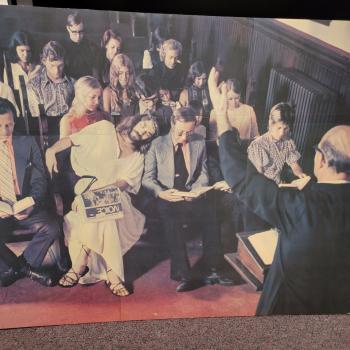Between pp. 944 and 966 we get as clear a short exposition of Tom’s views on ‘justification’ as one is likely to find, certainly more focused and succinct than in his book on Justification, and it merits a couple of blog posts of discussion. He will make seven points about his ‘seventh’ point in the sequence of Pauline thought that leads to Paul’s treatment of justification.
Firstly, it is Tom’s view that present justification is a declarative thing, God declaring a person ‘in the right’ or ‘within the covenant’ all those who hear, believe, and obey the Gospel of Jesus Christ (on obedience see Rom. 10.16; 2 Thess. 1.8). In his view the future verdict, often called final justification, is brought forward into the present. Unless one concludes that the phrase ‘the obedience of faith’ means faith as a form of obedience, then Tom is saying something rather different here than the traditional ‘justification by grace through faith’ (plus nothing, including no deeds or works) idea. He would also be at odds with John Wesley who argued that ‘initial’ justification is not simply final justification brought forward into the present, not least because final justification according to 2 Cor. 5.10 and other texts involves an evaluation of the believer’s works, and not just a matter of justification by faith. This being the case ‘initial justification’ is not the final verdict brought forward in time, from Wesley’s point of view. You will not be surprised to hear that I think Wesley is closer to the mark than Tom on this point.
I do however agree with Tom that one of the elements of initial justification is the declaration of ‘no condemnation’ or put Tom’s way, that this person is now ‘in the right’. I would prefer the phrase ‘set right’ rather than ‘in the right’ because that is what God does in the act of faith— he sets us right, not merely declares us to be in the right. In other words, initial justification is not just a matter of a legal declaration. The reason ‘set right’ is a better English equivalent is because previously the person in question was indeed ‘in the wrong’ and was under condemnation. It is not merely a matter of a court finding in favor a person who was wrongly accused of something. This is precisely why I think that the forensic approach can be pushed too far. I would stress again that the language of ‘reckoning’ is not law court but rather business language, the language of credits and debits. In fact ‘reckoned’ could just as well be translated ‘credited’.
Secondly, when a judge declares a person ‘not guilty’ or at least ‘not condemned’ (which has a different nuance than ‘not guilty’) he is not at the same time declaring a person to be either ‘in the right’ or ‘righteous’. That positive evaluation is another matter. I can’t say I’ve ever heard of a judge saying that a person was ‘dikaios’ when what he meant was that his guilt was not proved or that there would be no condemnation of whatever he did do. Nor do I know of any Greco-Roman or Jewish judge or court that talked like that. So for example when Paul speaks of pardon and of sins being covered the judge in that case is certainly not declaring a person ‘righteous’ or ‘in the right’ in any normal sense of those words. What he means is, despite what he has done, his sins have been paid for, and so he is not condemned— he is pardoned for his crimes, knowing quite well that he committed those sins and he has not himself paid for them.
What the declaration ‘no condemnation’ does do is ‘set right’ the accused, and gives him legal ‘right standing’. That’s all, and it has nothing to do with obedience. On p. 945 however Tom is right to say that the speech act of the judge, declaring ‘no condemnation’ does create a new status for the person– they have right standing before the law.
The further point made on p. 946 is spot on— that since the ‘set right’ or ‘right standing’ of the accused is declarative it has nothing to do with the ‘righteousness’ of the judge himself (or the transfer of the judge’s righteousness to the accused). Exactly right, which means such a declaration has nothing to do with the idea of ‘imputed righteousness’ in the usual sense of that phrase, nothing to do with the imputing of Christ’s righteousness to the believer. Here in n. 479 I think Tom has a point in critiquing both Gorman and McCormack– a legal declaration transforms only the status of the person in question, it does not transform their character. That is quite another matter. Justification only has to do with the former— the giving of someone right standing before the judge or law. It is however true that justification and the new birth are coincident in time so that the effective transformation of character, the real ‘setting right’ (internally) of the person transpires at the same juncture with the legal declaration of ‘no condemnation’ or ‘in right standing’ with the law. The critique in n. 480 of the traditional Reformed ways of framing this discussion and the muddling up of God’s righteousness with Christ’s and indeed with the believers right standing is well done here. He is right that Is. 61.10 does not refer to the righteousness of God, but to the ‘righteous’ status given as a gift by God to his people.
Is God thereby acquitting the guilty, or even saying they were in the right all along? On p. 948 Tom says, yes…and no, to such questions. More to the point Tom in good Reformed fashion wants to say that the declaration of the judge is permanent, not temporary. He says “the status of dikaiosune is not temporary. It truly anticipates the verdict which will be issued on the last day.” But since we have been using the analogy with human judicial processes all along, I will say that here is where he is wrong. The fact is that a person after such a legal judgment can go on to violate the law again, ‘even if he got off scott free the first time’ and will be judged again. And nothing about Paul’s discussion of final judgment suggests it is identical with the initial judgment, or is even done on entirely the same basis. Final judgment alone involves an evaluation of the believer’s works including a minister’s works, resulting in either rewards or ‘escaping as through fire’. While it is true that salvation is not on the BASIS of works, if one commits apostasy, one is disqualified from final salvation and final justification. And furthermore, there are rewards in the kingdom based on good behavior as well, though salvation itself is not a reward. While this issue is complex, it is definitely over simplifying what Paul actually says about justification to suggest it is simply final justification retrojected back in time, and it further muddles things up to say that the initial verdict is permanent (and precludes a different final verdict). This was neither Jesus nor Paul’s view, and for that matter, you will not find it elsewhere in early Judaism either, so far as I know. This is the view of Reformed theology, slipped into Paul’s narrative Jewish thought world.
On p. 949 Tom makes the correct point (his second sub-point) that this declaration of right standing is entirely dependent upon Christ’s death on the cross. The finished work of Christ opens up the new world of forgiveness, as Tom puts it.
On p. 950 we have the third sub point– namely the people declared to be ‘in the right’ (Tom’s language, not mine) are incorporated into the Messiah (not quite— they are incorporated into the body of Christ which is connected to the head who is Christ. This is what it means to be ‘in Christ’– see 1 Cor. 12). Tom equates the declaration of ‘Son of God with power’ by means of the resurrection (Rom. 1.3-4) with the declaration of believers as ‘adopted sons and daughters of God’). The problem is that this is probably not what Rom. 1.3-4 means— Jesus was appointed Son of God in power, not merely declared to be something. In other words, what happened to Jesus at the resurrection has nothing to do with a legal judgment, thought certainly the event vindicated his prior claims. But that is not the point in Rom. 1.3-4. Paul believes he had already been the Son of God before his resurrection, but that at the resurrection he went from being Son of God in weakness to Son of God in power. This was no mere legal declaration, it was a transformation of his very nature, now having a resurrection body, and so enabled to be Son of God in power— immune to disease, decay, and death. This is hardly analogous to the declaration of sinners as pardoned.
Tom is however right that what happened at the resurrection does not amount to Christ having a right standing which then could be imputed to believers who are ‘in him’. Tom is absolutely correct (p. 951) that Paul never speaks of Christ as ‘having righteousness’. He thinks not even 1 Cor. 1.30 says this (and I agree). What that says is Christ is God’s wisdom, and we become or receive those other things through him.

















